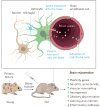Ageing, neurodegeneration and brain rejuvenation
- PMID: 27830812
- PMCID: PMC5172605
- DOI: 10.1038/nature20411
Ageing, neurodegeneration and brain rejuvenation
Abstract
Although systemic diseases take the biggest toll on human health and well-being, increasingly, a failing brain is the arbiter of a death preceded by a gradual loss of the essence of being. Ageing, which is fundamental to neurodegeneration and dementia, affects every organ in the body and seems to be encoded partly in a blood-based signature. Indeed, factors in the circulation have been shown to modulate ageing and to rejuvenate numerous organs, including the brain. The discovery of such factors, the identification of their origins and a deeper understanding of their functions is ushering in a new era in ageing and dementia research.
Figures



Similar articles
-
Qualitative evidence synthesis informing our understanding of people's perceptions and experiences of targeted digital communication.Cochrane Database Syst Rev. 2019 Oct 23;10(10):ED000141. doi: 10.1002/14651858.ED000141. Cochrane Database Syst Rev. 2019. PMID: 31643081 Free PMC article.
-
Depressing time: Waiting, melancholia, and the psychoanalytic practice of care.In: Kirtsoglou E, Simpson B, editors. The Time of Anthropology: Studies of Contemporary Chronopolitics. Abingdon: Routledge; 2020. Chapter 5. In: Kirtsoglou E, Simpson B, editors. The Time of Anthropology: Studies of Contemporary Chronopolitics. Abingdon: Routledge; 2020. Chapter 5. PMID: 36137063 Free Books & Documents. Review.
-
Combining Cold Atmospheric Plasma and Environmental Nanoparticle Removal Device Reduces Neurodegenerative Markers.Int J Mol Sci. 2024 Dec 3;25(23):12986. doi: 10.3390/ijms252312986. Int J Mol Sci. 2024. PMID: 39684696 Free PMC article.
-
Virus-induced brain pathology and the neuroinflammation-inflammation continuum: the neurochemists view.J Neural Transm (Vienna). 2024 Dec;131(12):1429-1453. doi: 10.1007/s00702-023-02723-5. Epub 2024 Jan 23. J Neural Transm (Vienna). 2024. PMID: 38261034 Free PMC article. Review.
-
Trends in Surgical and Nonsurgical Aesthetic Procedures: A 14-Year Analysis of the International Society of Aesthetic Plastic Surgery-ISAPS.Aesthetic Plast Surg. 2024 Oct;48(20):4217-4227. doi: 10.1007/s00266-024-04260-2. Epub 2024 Aug 5. Aesthetic Plast Surg. 2024. PMID: 39103642 Review.
Cited by
-
Cell-by-Cell Deconstruction of Stem Cell Niches.Cell Stem Cell. 2020 Jul 2;27(1):19-34. doi: 10.1016/j.stem.2020.06.013. Cell Stem Cell. 2020. PMID: 32619515 Free PMC article. Review.
-
Blood substitution therapy rescues the brain of mice from ischemic damage.Nat Commun. 2020 Aug 25;11(1):4078. doi: 10.1038/s41467-020-17930-x. Nat Commun. 2020. PMID: 32843630 Free PMC article.
-
Sex as a Determinant of Age-Related Changes in the Brain.Int J Mol Sci. 2024 Jun 28;25(13):7122. doi: 10.3390/ijms25137122. Int J Mol Sci. 2024. PMID: 39000227 Free PMC article. Review.
-
Finger-specific effects of age on tapping speed and motor fatigability.Front Hum Neurosci. 2024 Sep 25;18:1427336. doi: 10.3389/fnhum.2024.1427336. eCollection 2024. Front Hum Neurosci. 2024. PMID: 39386279 Free PMC article.
-
Mesenchymal Stem Cells as a Cornerstone in a Galaxy of Intercellular Signals: Basis for a New Era of Medicine.Int J Mol Sci. 2021 Mar 30;22(7):3576. doi: 10.3390/ijms22073576. Int J Mol Sci. 2021. PMID: 33808241 Free PMC article. Review.
References
-
- United Nations Department of Economic and Social Affairs Population Division. World Population Ageing 2015. Report ST/ESA/SER.A/390 http://www.un.org/en/development/desa/population/publications/pdf/ageing... (United Nations, 2015)
-
- Mrak RE, Griffin ST, Graham DI. Aging-associated changes in human brain. J Neuropathol Exp Neurol. 1997;56:1269–1275. - PubMed
-
- Brunk UT, Terman A. The mitochondrial-lysosomal axis theory of aging: accumulation of damaged mitochondria as a result of imperfect autophagocytosis. Eur J Biochem. 2002;269:1996–2002. - PubMed
Publication types
MeSH terms
Substances
Grants and funding
LinkOut - more resources
Full Text Sources
Other Literature Sources
Medical

